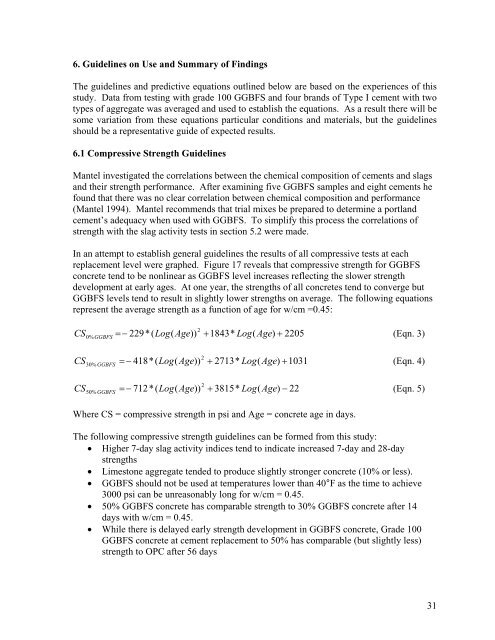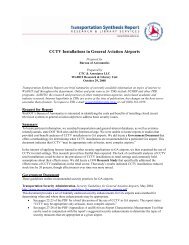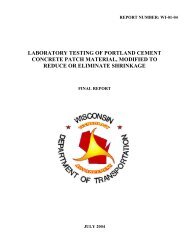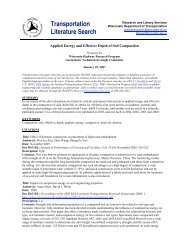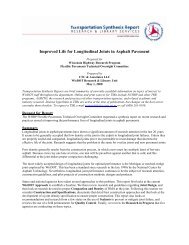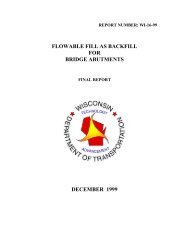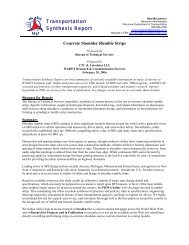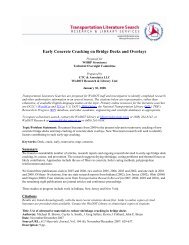Effects of Ground Granulated Blast Furnace Slag in Portland Cement ...
Effects of Ground Granulated Blast Furnace Slag in Portland Cement ...
Effects of Ground Granulated Blast Furnace Slag in Portland Cement ...
You also want an ePaper? Increase the reach of your titles
YUMPU automatically turns print PDFs into web optimized ePapers that Google loves.
6. Guidel<strong>in</strong>es on Use and Summary <strong>of</strong> F<strong>in</strong>d<strong>in</strong>gs<br />
The guidel<strong>in</strong>es and predictive equations outl<strong>in</strong>ed below are based on the experiences <strong>of</strong> this<br />
study. Data from test<strong>in</strong>g with grade 100 GGBFS and four brands <strong>of</strong> Type I cement with two<br />
types <strong>of</strong> aggregate was averaged and used to establish the equations. As a result there will be<br />
some variation from these equations particular conditions and materials, but the guidel<strong>in</strong>es<br />
should be a representative guide <strong>of</strong> expected results.<br />
6.1 Compressive Strength Guidel<strong>in</strong>es<br />
Mantel <strong>in</strong>vestigated the correlations between the chemical composition <strong>of</strong> cements and slags<br />
and their strength performance. After exam<strong>in</strong><strong>in</strong>g five GGBFS samples and eight cements he<br />
found that there was no clear correlation between chemical composition and performance<br />
(Mantel 1994). Mantel recommends that trial mixes be prepared to determ<strong>in</strong>e a portland<br />
cement’s adequacy when used with GGBFS. To simplify this process the correlations <strong>of</strong><br />
strength with the slag activity tests <strong>in</strong> section 5.2 were made.<br />
In an attempt to establish general guidel<strong>in</strong>es the results <strong>of</strong> all compressive tests at each<br />
replacement level were graphed. Figure 17 reveals that compressive strength for GGBFS<br />
concrete tend to be nonl<strong>in</strong>ear as GGBFS level <strong>in</strong>creases reflect<strong>in</strong>g the slower strength<br />
development at early ages. At one year, the strengths <strong>of</strong> all concretes tend to converge but<br />
GGBFS levels tend to result <strong>in</strong> slightly lower strengths on average. The follow<strong>in</strong>g equations<br />
represent the average strength as a function <strong>of</strong> age for w/cm =0.45:<br />
CS<br />
2<br />
GGBFS<br />
= − 229*( Log(<br />
Age))<br />
+ 1843* Log(<br />
Age)<br />
2205<br />
(Eqn. 3)<br />
0 %<br />
+<br />
2<br />
CS<br />
GGBFS<br />
= − 418*( Log(<br />
Age))<br />
+ 2713* Log(<br />
Age)<br />
1031<br />
(Eqn. 4)<br />
30 %<br />
+<br />
2<br />
CS GGBFS<br />
= − 712*( Log(<br />
Age))<br />
+ 3815* Log(<br />
Age)<br />
22<br />
(Eqn. 5)<br />
50%<br />
−<br />
Where CS = compressive strength <strong>in</strong> psi and Age = concrete age <strong>in</strong> days.<br />
The follow<strong>in</strong>g compressive strength guidel<strong>in</strong>es can be formed from this study:<br />
• Higher 7-day slag activity <strong>in</strong>dices tend to <strong>in</strong>dicate <strong>in</strong>creased 7-day and 28-day<br />
strengths<br />
• Limestone aggregate tended to produce slightly stronger concrete (10% or less).<br />
• GGBFS should not be used at temperatures lower than 40°F as the time to achieve<br />
3000 psi can be unreasonably long for w/cm = 0.45.<br />
• 50% GGBFS concrete has comparable strength to 30% GGBFS concrete after 14<br />
days with w/cm = 0.45.<br />
• While there is delayed early strength development <strong>in</strong> GGBFS concrete, Grade 100<br />
GGBFS concrete at cement replacement to 50% has comparable (but slightly less)<br />
strength to OPC after 56 days<br />
31


